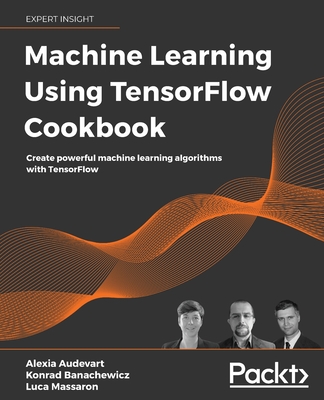Applied Deep Learning: A Case-Based Approach to Understanding Deep Neural Networks
暫譯: 應用深度學習:基於案例的方法理解深度神經網絡
Umberto Michelucci
- 出版商: Apress
- 出版日期: 2018-09-08
- 定價: $2,180
- 售價: 6.0 折 $1,308
- 語言: 英文
- 頁數: 432
- 裝訂: Paperback
- ISBN: 1484237897
- ISBN-13: 9781484237892
-
相關分類:
DeepLearning
-
相關翻譯:
深度學習:基於案例理解深度神經網絡 (簡中版)
立即出貨 (庫存 < 3)
買這商品的人也買了...
-
 類神經網路與模糊控制理論入門與應用
類神經網路與模糊控制理論入門與應用$350$315 -
 Predictive Analytics with TensorFlow
Predictive Analytics with TensorFlow$1,820$1,729 -
 TensorFlow: Powerful Predictive Analytics with TensorFlow
TensorFlow: Powerful Predictive Analytics with TensorFlow$1,640$1,558 -
 強化學習精要:核心算法與 TensorFlow 實現
強化學習精要:核心算法與 TensorFlow 實現$480$456 -
 Hands-On Automated Machine Learning: A beginner's guide to building automated machine learning systems using AutoML and Python
Hands-On Automated Machine Learning: A beginner's guide to building automated machine learning systems using AutoML and Python$1,380$1,311 -
 $308GAN : 實戰生成對抗網絡
$308GAN : 實戰生成對抗網絡 -
 三菱可程式控制器 FX3U-1PG 單軸伺服定位模組中文使用手冊中文使用手冊
三菱可程式控制器 FX3U-1PG 單軸伺服定位模組中文使用手冊中文使用手冊$500$475 -
 $234AlphaGo 如何戰勝人類圍棋大師 — 智能硬件 TensorFlow 實踐
$234AlphaGo 如何戰勝人類圍棋大師 — 智能硬件 TensorFlow 實踐 -
 $207PHP7.0+MySQL網站開發全程實例
$207PHP7.0+MySQL網站開發全程實例 -
 Python 網路爬蟲與資料分析入門實戰
Python 網路爬蟲與資料分析入門實戰$450$351 -
 CSS Master
CSS Master$1,490$1,416 -
 Hands-On Markov Models with Python: Implement probabilistic models for learning complex data sequences using the Python ecosystem
Hands-On Markov Models with Python: Implement probabilistic models for learning complex data sequences using the Python ecosystem$1,490$1,416 -
 還在漫無頭緒?一本書帶你走完 Python 深度學習
還在漫無頭緒?一本書帶你走完 Python 深度學習$690$587 -
 無印良品的 PDCA:常勝經營法,一本筆記本就夠了!
無印良品的 PDCA:常勝經營法,一本筆記本就夠了!$350$298
相關主題
商品描述
Work with advanced topics in deep learning, such as optimization algorithms, hyper-parameter tuning, dropout, and error analysis as well as strategies to address typical problems encountered when training deep neural networks. You’ll begin by studying the activation functions mostly with a single neuron (ReLu, sigmoid, and Swish), seeing how to perform linear and logistic regression using TensorFlow, and choosing the right cost function.
The next section talks about more complicated neural network architectures with several layers and neurons and explores the problem of random initialization of weights. An entire chapter is dedicated to a complete overview of neural network error analysis, giving examples of solving problems originating from variance, bias, overfitting, and datasets coming from different distributions.
Applied Deep Learning also discusses how to implement logistic regression completely from scratch without using any Python library except NumPy, to let you appreciate how libraries such as TensorFlow allow quick and efficient experiments. Case studies for each method are included to put into practice all theoretical information. You’ll discover tips and tricks for writing optimized Python code (for example vectorizing loops with NumPy).
What You Will Learn
- Implement advanced techniques in the right way in Python and TensorFlow
- Debug and optimize advanced methods (such as dropout and regularization)
- Carry out error analysis (to realize if one has a bias problem, a variance problem, a data offset problem, and so on)
- Set up a machine learning project focused on deep learning on a complex dataset
Who This Book Is For
Readers with a medium understanding of machine learning, linear algebra, calculus, and basic Python programming.
商品描述(中文翻譯)
深入探討深度學習中的進階主題,例如優化算法、超參數調整、隨機失活(dropout)和錯誤分析,以及解決訓練深度神經網絡時常見問題的策略。您將首先學習激活函數,主要針對單一神經元(ReLu、sigmoid 和 Swish),了解如何使用 TensorFlow 執行線性和邏輯回歸,並選擇合適的成本函數。
接下來的部分將討論更複雜的神經網絡架構,包括多層和多神經元,並探討權重隨機初始化的問題。整個章節專門介紹神經網絡錯誤分析的完整概述,舉例說明如何解決來自方差、偏差、過擬合以及來自不同分佈的數據集所產生的問題。
應用深度學習還討論如何完全從零開始實現邏輯回歸,而不使用任何 Python 庫,除了 NumPy,讓您能夠體會像 TensorFlow 這樣的庫如何允許快速且高效的實驗。每種方法都包含案例研究,以便將所有理論信息付諸實踐。您將發現撰寫優化 Python 代碼的技巧和竅門(例如使用 NumPy 向量化循環)。
您將學到什麼
- 在 Python 和 TensorFlow 中以正確的方式實現進階技術
- 調試和優化進階方法(例如隨機失活和正則化)
- 進行錯誤分析(以了解是否存在偏差問題、方差問題、數據偏移問題等)
- 設置一個專注於深度學習的機器學習項目,針對複雜數據集
本書適合誰閱讀
對機器學習、線性代數、微積分和基本 Python 編程有中等理解的讀者。












